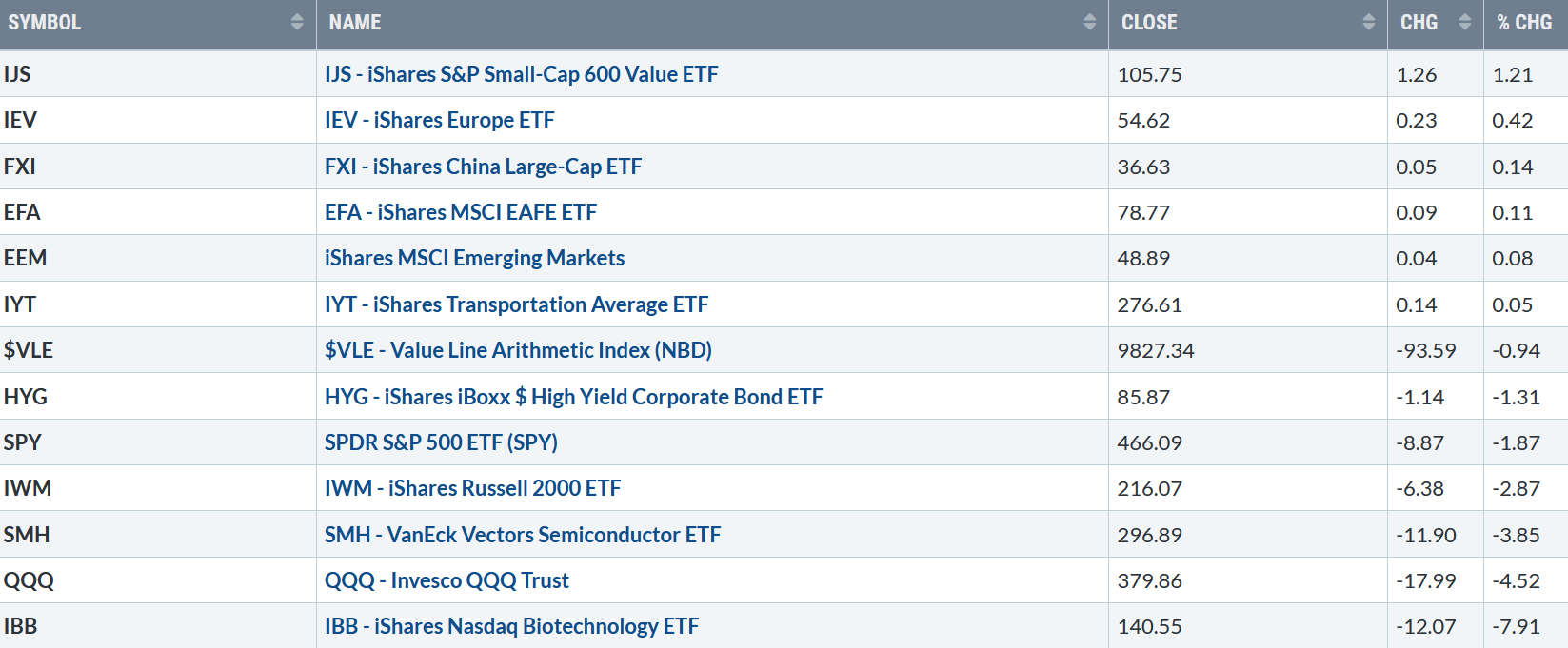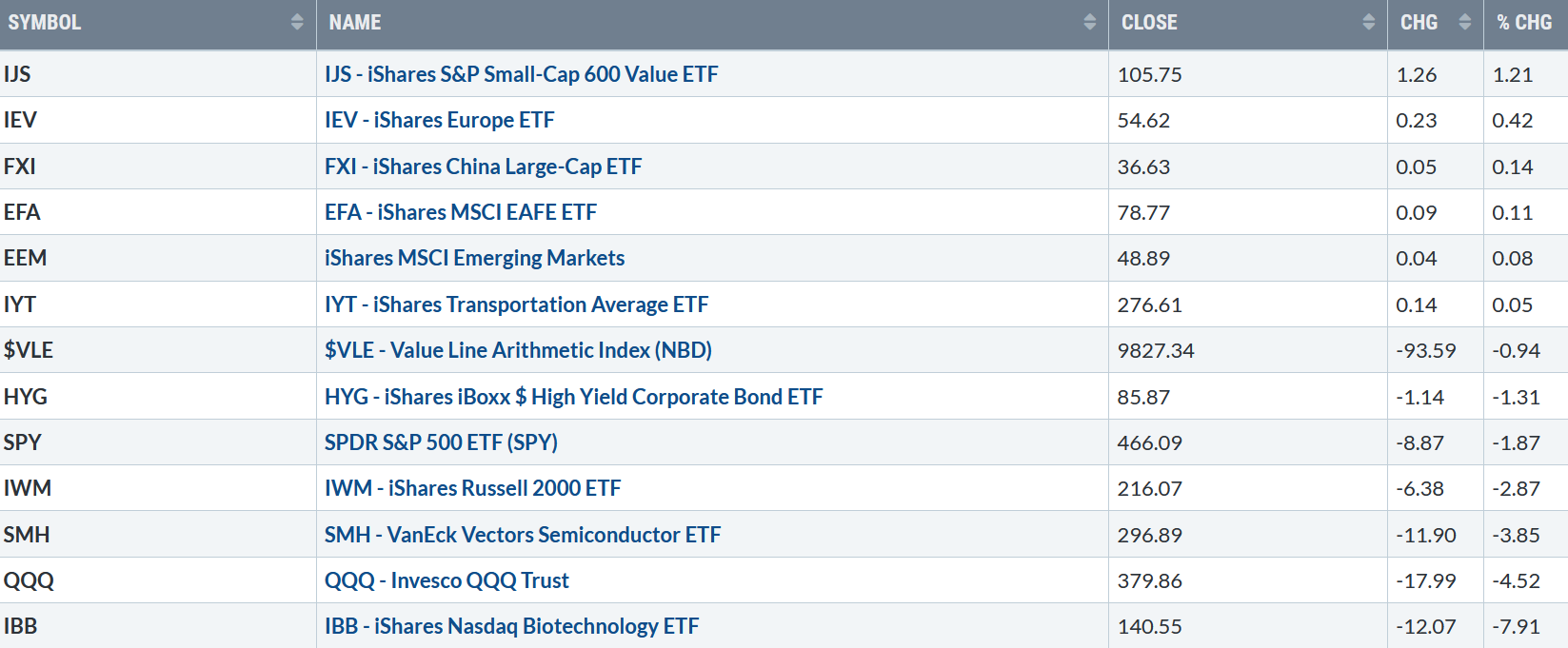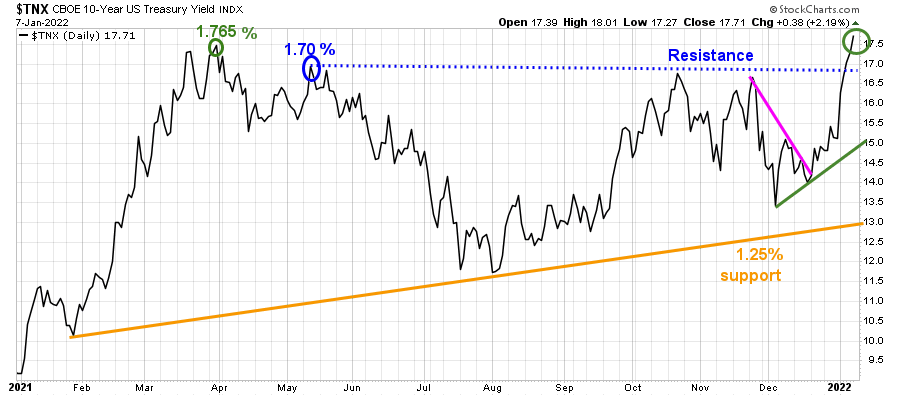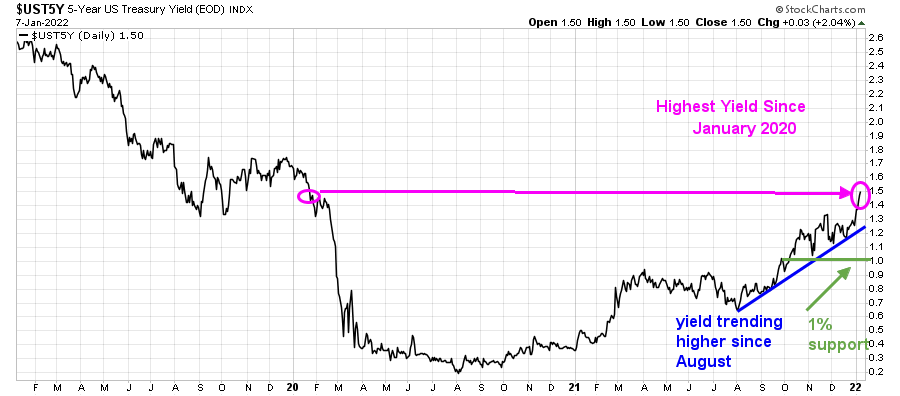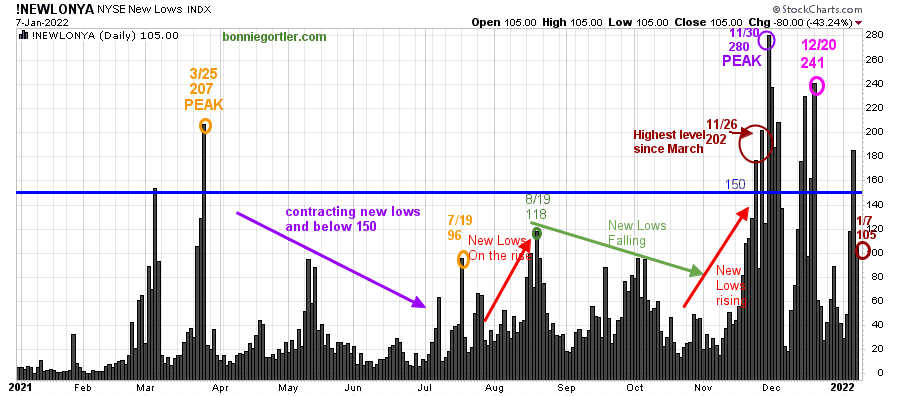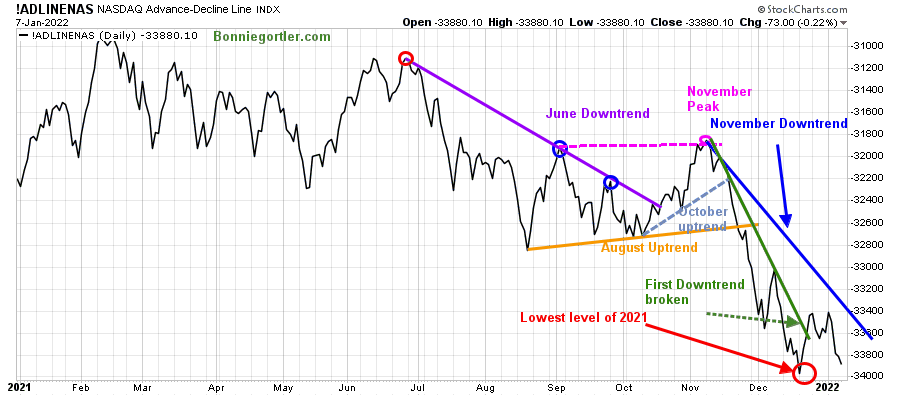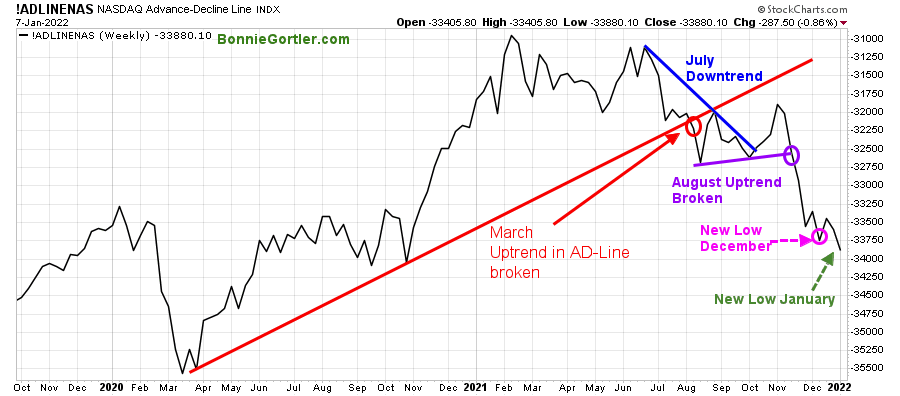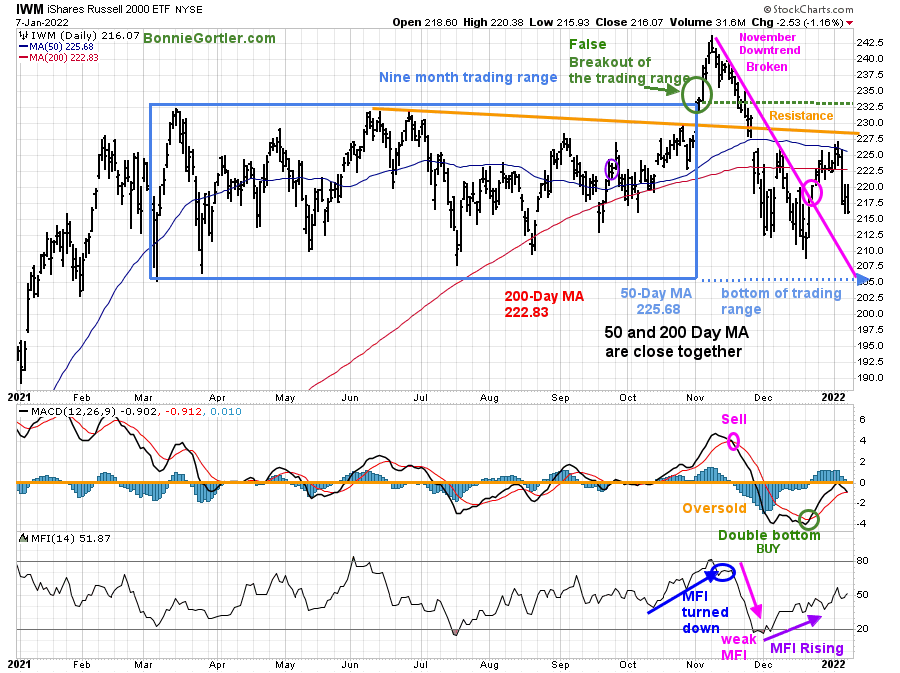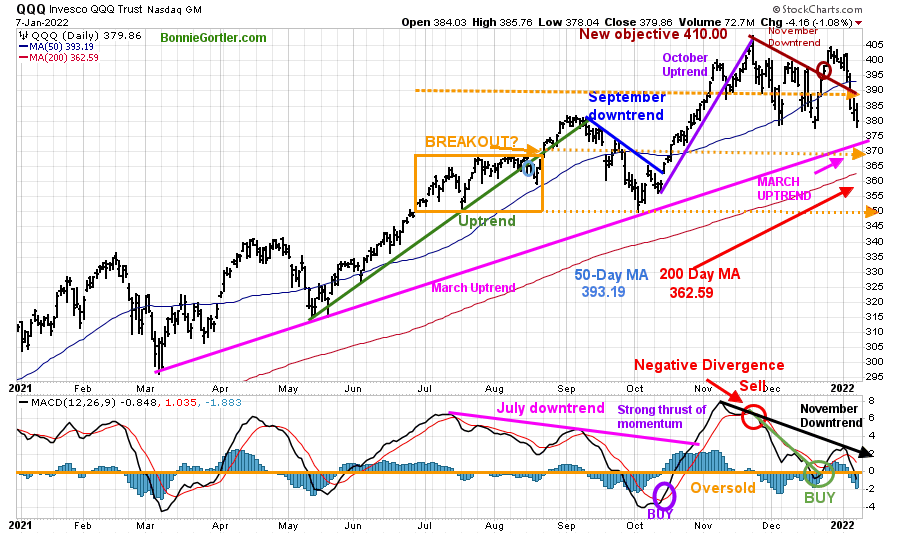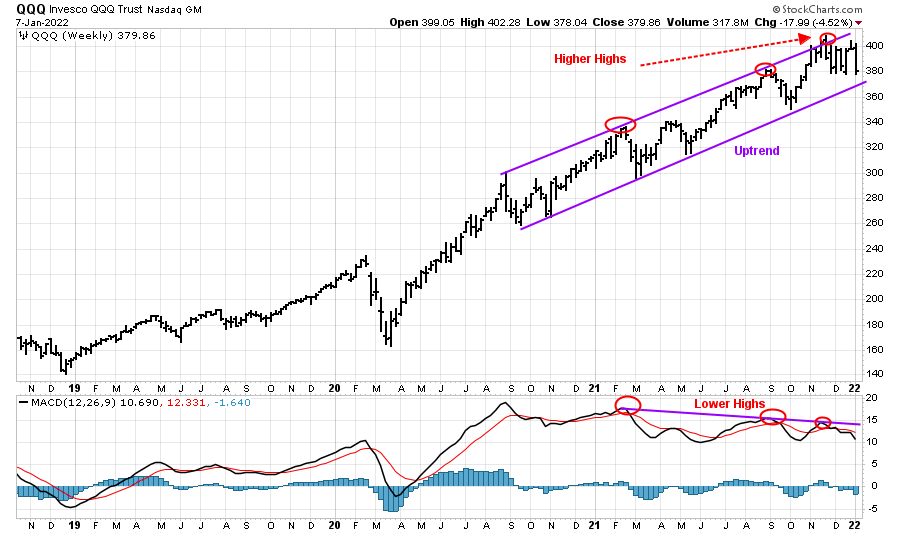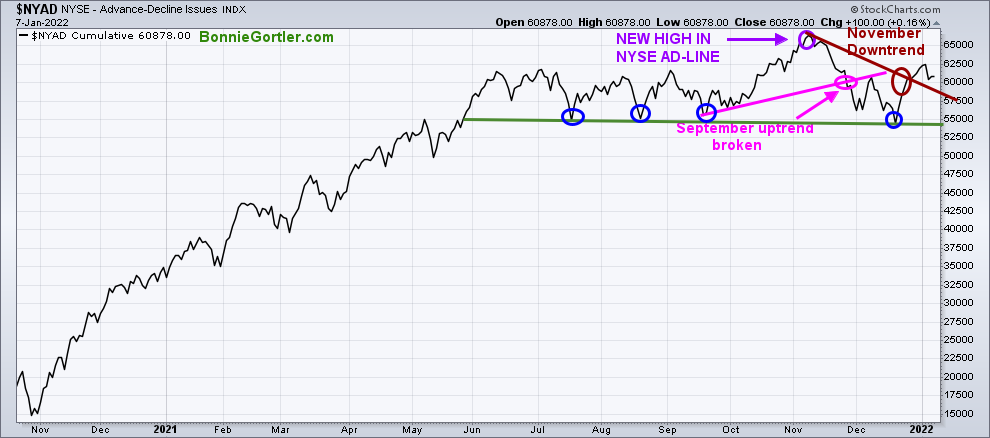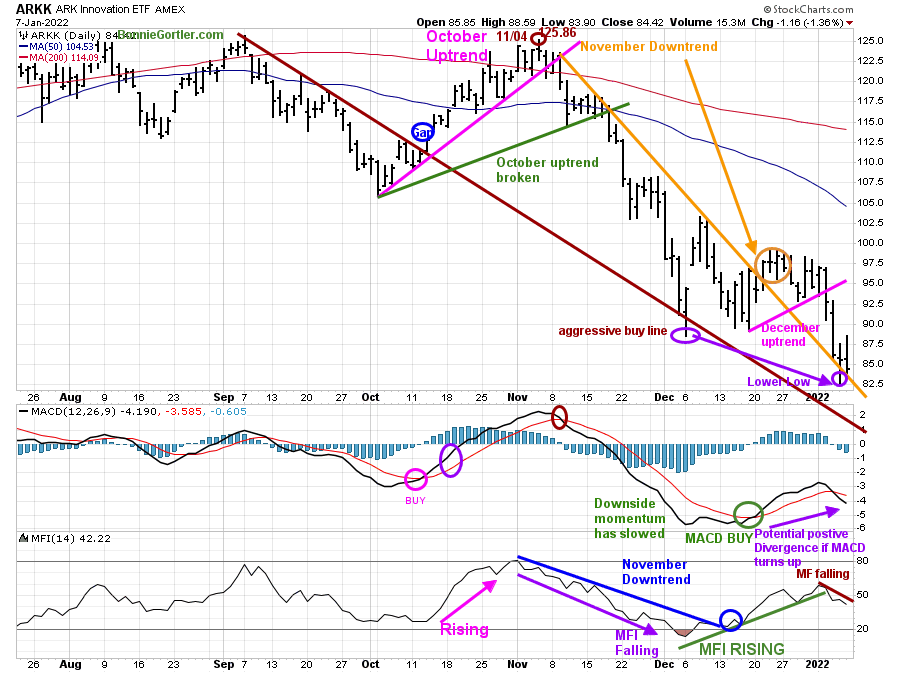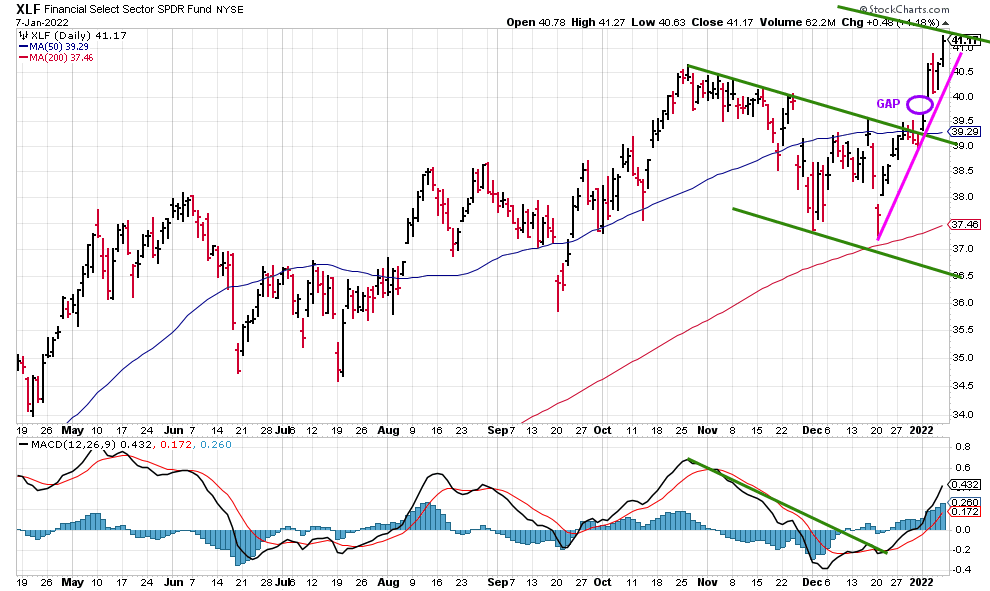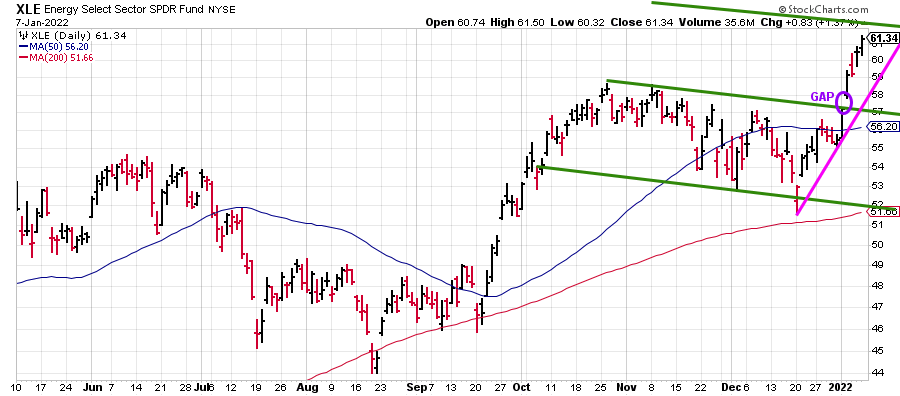Four of the eleven sectors rose, with seven sectors performing better than the SPDR S&P 500 ETF Trust (SPY) down -1.87%. Energy (XLE) and Financials (XLF) were the leading sectors, while Health Care (XLV) and Real Estate (XLRE) were the weakest.
S&P SPDR Sector ETFs Performance Summary
12/31/21 – 1/07/22
Source: Stockcharts.com
Figure 2: Bonnie’s Mix of ETFs To Monitor
Summary 12/31/21-1/07/22
Source: Stockcharts.com
Technology and Biotech sold off. International markets showed slight gains and starting to improve in relative strength.
For the week, the Dow fell -0.29 %, the S&P 500 lost -1.87%, and the Nasdaq was down -4.53%. The Russell 2000 Index fell -2.92%, and the Value Line Arithmetic Index (a mix of approximately 1700 stocks) fell -0.94%.
10-Year U.S. Treasury yields rose sharply, putting pressure on growth stocks, closing at 1.771% (green circle Figure:3), its highest level since March last year. 5-Year U.S. Treasury yields rose to 1.50%, the highest since January 2020 (pink circle Figure:4).
Figure 3:10-Year U.S. Treasury Yield
Source: Stockcharts.com
Figure 4: 5-Year U.S. Treasury Yield
Source: Stockcharts.com
Weekly market breadth faltered. The New York Stock Exchange Index (NYSE) had 1489 advances and 2084 declines. Nasdaq had 1999 advances and 3173 declines. There were 301 New Highs and 276 New Lows on the NYSE and 348 New Highs, and 871 New Lows on the Nasdaq. Market breadth needs to improve in the near term for the major averages to continue higher.
Figure 5: Daily New York Stock Exchange (NYSE) New Lows
Source: Stockcharts.com
Watching New lows on the New York Stock Exchange is a simple technical tool that helps awareness about the immediate trend’s direction.
Learn more in my book, Journey to Wealth. Here is an excerpt, If the New Lows are above 50, it is an alert or warning of possible market weakness or a change in market tone. Be aware, it’s a good idea to make sure you are happy and comfortable with your portfolio. It is best not to have more volatile investments than you can handle where you feel uncomfortable. If the selling continues, you could have serious losses if the market falls further. When new lows are above 150, the market is negative, higher risk, selling is taking place. Sometimes it could be severe, and sometimes on a very nasty day, you can have “panic selling,” and big wild swings (high volatility) to the downside may occur.
New lows inched up last week, not expanding over the previous peak of 280 on 11/30 (purple circle as the market fell. New Lows closed at 105 (brown circle), no longer in a low-risk zone where prices tend to rise but below 150, a positive sign.
Keep an eye if New Lows fall between 25 and 50. It would be favorable for the near term. On the other hand, News lows closing above 150 would signify more caution needed in the near term.
Figure 6: Daily Nasdaq Advance-Decline Line
Source: Stockcharts.com
The daily Nasdaq AD-Line broke the June downtrend (purple line), peaking in early November then turned down, breaking the October uptrend (blue dotted line), an advanced warning a decline was forthcoming. After the August uptrend broke (orange line), a series of new lows in December occurred.
The first downtrend was broken (green line) but failed to gain enough strength to break the November downtrend (blue line). Until broken, the risk in growth stocks with no earnings is high.
On the other hand, a turn up would create a double bottom, and if strong enough to break the downtrend, it would be positive and likely attract buying into beaten up grow stocks that have been under selling pressure.
Figure 7: Weekly Nasdaq Advance-Decline Line
Source: Stockcharts.com
After breaking down in August, the Nasdaq-line Weekly AD-Line made a few attempts to form a bottom.
A turn-up was needed last week to form a double bottom. However, with the weakness in Nasdaq, a new low was made, implying risk remains high of further downside. More time is needed to develop a safe buying pattern for the intermediate trend.
Figure 8: Daily iShares Russell 2000 (IWM) Price (Top) and 12-26-9 MACD (Middle and Money Flow (Bottom)
Source: Stockcharts.com
The top portion of the chart is the daily iShares Russell 2000 Index ETF (IWM), the benchmark for small-cap stocks, with a 50-Day Moving Average (MA) (blue line) and 200-Day Moving Average (MA), that traders watch and use to define trends.
In November, a false breakout occurred in IWM after being in a nine-month trading range. IWM broke the November downtrend but could not get above resistance and turned lower. IWM continues to close below its 50 and 200-Day Moving Average, favoring the bears.
IWM last week closed at 216.07, down -2.87%. A close above the 50 and 200-Day Moving Averages, which are close together, would likely trip the stops and begin to excite the bulls.
Resistance is 220.00, 222.00, 228, followed by 232.50. Support is 210.00, followed by 205.00.
MACD (middle chart) remains on a buy, falling and failing to get above 0. However, a turn-up now in MACD would be positive. On the other hand, further weakness in MACD would imply the decline will continue to between 205.00 and 210.00.
Money Flow (lower chart) is rising, a positive sign that investors are still interested in small caps despite the decline.
Figure 9: Daily Invesco QQQ Trust (QQQ) Price (Top), and 12-26-9 MACD (Bottom)
Source: Stockcharts.com
The chart shows the daily Invesco QQQ, an exchange-traded fund based on the Nasdaq 100 Index with its 50-Day Moving Average and 200-Day Moving Average. In June, QQQ was in a trading range (orange rectangle) followed by a breakout that failed, a decline followed to 350.00 in late September. After breaking the short-term downtrend 10/7 (blue line), QQQ continued to climb in November, close to its upside target of 410.00 on 11/22 with a high of 408.71 before reversing lower.
Two weeks ago, QQQ broke the November downtrend. Last week QQQ failed to make a new high and turned sharply lower, down -4.52%, breaking below the first support at 390.00 and closed at the next support area 379.86 mentioned in the 12/31/21 market update. Stops hit after QQQ broke below its 50 Day-Moving Average, which is not a sign of strength. On the other hand, it remains positive the March uptrend (top chart) remains intact (pink line).
Support is between 370.00 and 372.00, a vital area that needs to hold. Resistance is at 380.00 followed by 390.00 and 400.00 with an upside objective to 410.00. A close below 370.00 would shift the trend to down, making it harder to make money and likely fuel more selling in Nasdaq.
The lower chart is MACD (12, 26, 9), a measure of momentum remains on a buy. However, MACD has been falling and in a downtrend since November (black line). As long as momentum is falling risk is high of further selling. Watch for MACD to begin to flatten and then turn up, followed by a break of the November downtrend. When this occurs, it will signify that the short-term selling is complete.
Figure 10: Weekly Invesco QQQ Trust (QQQ) Price (Top), and 12-26-9 MACD (Bottom)
Source: Stockcharts.com
The top chart shows the weekly Invesco QQQ Trust (QQQ) has been in an intermediate uptrend since September 2020 and remains intact. On the other hand, it’s worrisome; QQQ made higher highs peaking in November (red circles) and closed near its low for the week.
MACD (lower chart) remains on a sell, making lower highs, weakening momentum, forming a negative divergence (price high unconfirmed by MACD, which is making lower highs).
Figure 11: Van Eck Semiconductors (SMH) Daily Price (Top), 12-26-9 MACD (Middle) and, Money Flow (bottom)
Source: Stockcharts.com
Semiconductors had a great run in October, leading the technology sector higher, but in late November, the October uptrend was broken (blue line), implying the easy money is over.
Semiconductors closed near their low for the week, falling sharply -3.85%, closing at 296.89 slightly above support at 295.00. However, its negative SMH failed to hold above the November downtrend where SMH broke out and its 50-Week Moving Average.
Support is at 290.00 followed by 275.00. Resistance is at 305.00, followed by 312.00 and 320.00.
MACD (middle chart) remains on a sell after very strong momentum in November. For a safe entry, more time is needed for MACD to reset and go below 0. In the meantime, any near-term strength where MACD turns up and breaks the downtrend would be positive. There is no guarantee of a reset below 0.
Money flow (lower chart) has flattened. However, it’s in a downtrend (green line) and needs to start rising for a sustainable rally to occur.
Much of the market started in 2022 lower, especially growth while value rose.
Keep an eye on NYSE Market breadth for short-term direction.
Figure 12: New York Stock Exchange AD-Line
Source: Stockcharts.com
In the top portion of the chart (Figure:11), The NYSE A/D line made a new high on 11/8/21, but it has trended down since then.
Last week, the AD line broke the November downtrend (brown line), a positive sign. However, a turn down without making a new high in the AD Line would be a warning of a pending correction forthcoming in the NYSE sooner than later.
The lows made in July, August, September, and December are essential to hold (blue circles), or a more severe correction is likely.
Figure 13: ARKK Innovation
Source: Stockcharts.com
ARKK, an actively managed ETF by Cathie Wood that seeks long-term growth.
ARKK broke its September short-term downtrend (brown line) in October and gapped up, followed by a failed rally peaking at 125.86 on 11/04.
With the Nasdaq under selling pressure, ARKK fell below support at 94.00 and broke through the December uptrend (pink line) at 90.00. ARKK was hit hard, down -10.75% last week, closing at 84.42.
MACD is on a buy, but MACD never made it above 0, implying weak momentum after being extremely oversold.
Money flow (lower chart) broke the December uptrend and is now falling.
It’s worth watching to see if ARKK can stabilize and begin to rise even if the broad market weakens, as a sign that traders are stepping into buying growth stocks. A potential favorable positive divergence exists in MACD, so be alert to a sharp, quick turn when a shift in trend occurs.
Short-term resistance is 90.00, followed by 95.00. If ARKK continues to fall, an aggressive buy area is 77.00, not traded there since July 2020. ARKK is high-risk, volatile, with the bears in control.
What sectors are showing strength?
Figure 14: Financial Select SPDR (XLF)
Source: Stockcharts.com
With yields rising, growth stock under pressure, investors rotated heavily into the Financial (XLF) sector, the first week of starting 2022.
XLF rose +5.43%, gapping higher Monday, hitting the daily upper channel in one week. If yields continue to increase, it’s likely XLF will make higher highs. However, if yields stop rising, a pullback to 40.00 followed by 39.00 is possible in the near term.
Figure 15: Energy Select SPDR (XLE)
Source: Stockcharts.com
Investors also rotated heavily into the Energy (XLE) sector in the first week of January.
XLE rose sharply +10.52%, gapping higher on Monday, almost hitting the upper channel; a close above 62.00 would imply an objective of 67.00.
Short-term support is 59.00, followed by 57.00 in the near term.
Summing Up:
S&P 500 and Nasdaq fell four days in a row to begin 2022 as yields rose sharply. Investors rebalanced, rotating into Financials and Energy. Market breadth on both the NYSE and Nasdaq and continues to be concerning. After breaking below support, the Semiconductors and Technology sold off and accelerated to the downside. Watch early in the week if yields stop rising and move sideways, trending lower. Keep an eye on market breadth if New Lows on the NYSE and Nasdaq contract, not expand. If the Technology sector continues lower, last week’s decline will accelerate and likely spread to the broad market, increasing daily volatility and risk. It’s early in the year, be patient for safer buying opportunities to develop.
Remember to manage your risk, and your wealth will grow.
If you liked this article, you will love my Free Charting Master Class. Get it here:
See more charts in my FB group Wealth Through Market Charts.
I would love to hear from you. If you have any questions or comments or would like to talk about the market, click here.
Disclaimer: Although the information is made with a sincere effort for accuracy, it is not guaranteed that the information provided is a statement of fact. Nor can we guarantee the results of following any of the recommendations made herein. Readers are encouraged to meet with their own advisors to consider the suitability of investments for their own particular situations and for determination of their own risk levels. Past performance does not guarantee any future results.


